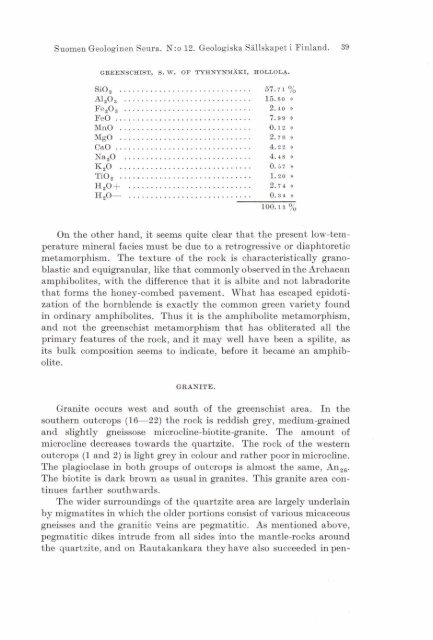GOHMISSION GEOLOGIQVE - Arkisto.gsf.fi
GOHMISSION GEOLOGIQVE - Arkisto.gsf.fi
GOHMISSION GEOLOGIQVE - Arkisto.gsf.fi
You also want an ePaper? Increase the reach of your titles
YUMPU automatically turns print PDFs into web optimized ePapers that Google loves.
Suomen Geologinen Seura. N:o 12. Geologiska Sallskapet i Finland. 39<br />
SiO, ..............................<br />
Al,Os .............................<br />
Fe,O, .............................<br />
FeO ...............................<br />
MnO ..............................<br />
MgO ..............................<br />
CaO ...............................<br />
Na,O .............................<br />
K,O ..............................<br />
TiO, ..............................<br />
H,O+ ............................<br />
On the other hand, it seems quite clear that the present low-temperature<br />
mineral facies must be due to a retrogressive or diaphtoretic<br />
metamorphism. The texture of the rock is characteristically granoblastic<br />
and equigranular, like that commonly observed in the Archaean<br />
amphibolites, with the difference that it is albite and not labradorite<br />
that forms the honey-combed pavement. What has escaped epidotization<br />
of the hornblende is exactly the common green variety found<br />
in ordinary amphibolites. Thus it is the amphibolite metamorphism,<br />
and not the greenschist metamorphism that has obliterated all the<br />
primary features of the rock, and it may well have been a spili*, as<br />
its bulk composition seems to indicate, before ih became an amphibolite.<br />
QRANITE.<br />
Granite occurs west and south of the greenschist ärea. In the<br />
southern outcrops (16-22) the rock is reddish grey, medium-grained<br />
and slightly gneissose microcline-biotite-granite. The amount of<br />
microcline decreases towards the quartzite. The rock of the western<br />
outcrops (1 and 2) is light grey in colour and rather poor in microcline.<br />
The plagioclase in both groups of outcrops is almost the same, An,,.<br />
The biotite is dark brown as usual in granites. This granite area continues<br />
farther southwards.<br />
The wider surroundings of the quartzite area are largely underlain<br />
by migrnatites in which the older portions consist of various micaceous<br />
gneisses and the granitic veins are pegmatitic. As mentioned above,<br />
pegmatitic dikes intrude from all sides into the mantle-rocks around<br />
the quartzite, and on Rautakankara they have also succeeded in pen-
















